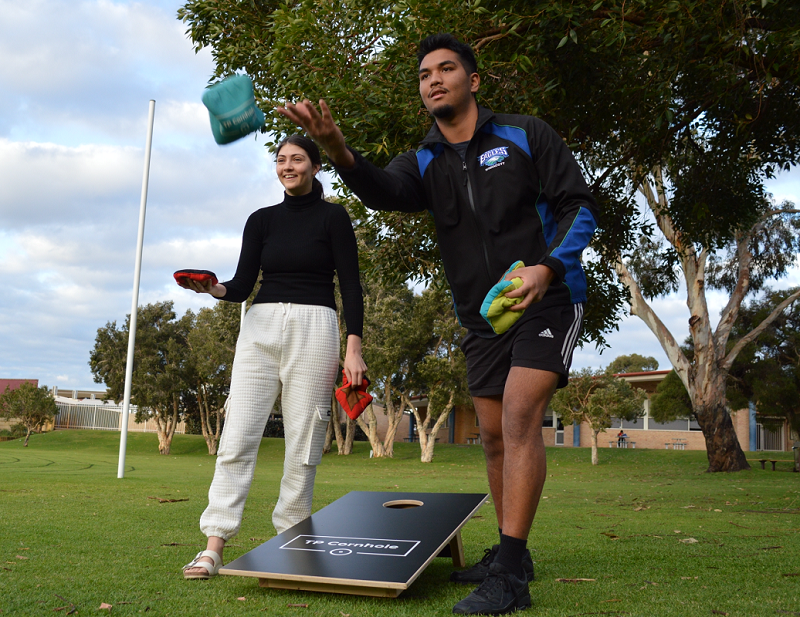
CORNHOLE
THE HISTORY
The origins of the game of cornhole are vague. Some say the early people of the prairies played a field game that involved throwing a corn-filled animal bladder into a hole of some kind. Others believe that Mattaius Kuepermann, a cabinet maker from Germany, may have invented the game, in 1325. The cabinet maker had noticed that some local children were throwing stones into a road-side hole, which looked dangerous! So, with left-over materials from his workshop (or shed), he created a great game, and solved a dangerous problem, all at one time!
TP History is relatively short in the context of the game itself. We discovered cornhole through a friend, who by the way was very good at it, and insisted that if we played it we’d love it. He was right! The fact that he had competed in and won the only cornhole tournament held in Perth 3 times over the years, inspired us even more. Getting good equipment was difficult. Out of need comes necessity. With one of us building boards and the other stitching bags we began supplying our buddies and interested family members with gear. We recognized a ground-swell of interest. In a short space of time, from a word no one seemed to have heard of before to it possibly becoming an Olympic sport, Cornhole had arrived!
The development of the unique pine ladder frame came from necessity, again. It not only strengthens the boards, it also lightens them by reducing the amount of timber required in the build. It also reduces the noise of the bag landing on the deck and creates the very cool “floating” effect when the board is on the ground. The folding legs and rope handle, which are strong features of the unique pine ladder frame, make storage and handling easier.
After starting out with form ply, which we still use in our Midnight Range, creating boards from hard wood tops was a no-brainer. The beauty of timber is irresistible and jarrah and karri are as Western Australian as you can get! So is Sheoke! But they are all heavy, so the reduced weight of the pine ladder frame helped again! The timber tops are finished with hard wax oil and this create an immaculate playing surface. We were producing beautiful hardwood cornhole boards like no one else! Customers commented it was just like buying a piece of beautiful furniture.
We have since introduced our new light-weight Acacia Series. These are still built on our revolutionary pine ladder frame, but with a lighter plywood top. The top is finish with the same hard wax oil used on the Timber Series.
As you would know to play cornhole you need a board for sure, but the bag is what goes in the hole! Sticking with tradition, and focusing on international competition standards, our first bags were 6 x 6 inch cotton canvas squares filled with 1 pound of field maize. The maize was grown in Cunderdin, in the wheatbelt, and the cotton canvas imported from India, and it came in a great range of colours. Joining off cuts to save waste led to our “Footy Range”. We produced a wide range of plain, mixed colour and tie dyed bags. Constantly experimenting with changing one side of the bag to alter its path to the hole started with the “Bravehearts”.
By rough stitching some extra pieces of canvas onto one side of the bag, we were testing out ways to alter the speed of the bag on the deck after it had landed. The extra pieces were red on purple and in the design of William Wallaces’ War Standard, so they were called Bravehearts. The idea was to increase the surface area and create more friction, thus turning or altering the natural pathway of the bag.
We also believed that producing a bag with multiple stripes on one side, for example blue and white alternate strips to look like a Geelong jumper, could also alter the path of the bag. The internal hem on each of the strips creates a rib. The more stripes the more ribs. If the bag in thrown accurately, and lands on the stripped side, it could cause the bag to change direction. These ribs disrupt the natural movement of the corn in the bag, and therefore could alter the natural pathway of the bag. Most of this extensive R&D was done on Friday afternoons with a beer!
The biggest change came when we trimmed off the 90 degree corners, moved to the faux suede patch and moved away from the corn. To create a more long lasting bag it was important to move with the times. To be able to wash your bags and keep them clean was a necessity, but finding the right fill was the tricky part. Finding a resin pellet that was similar in size to a corn kernel wasn’t hard, but matching the weight to the volume was. We ended up with a blend of new plastic resin pellets that are very small but have a specific gravity of over 1, usually used to make water bottles, and recycled plastic rough cuts to create the “feel” of corn. We fine tuned it but eventually abandoned the blending.
We now produce 4 types of bags: TP Sliders come in red and blue and are cotton canvas on both sides. TP Trackers come in many colours and have a suede patch on one side to create greater friction. TP All Starz are black, Limited Edition bags with a star shaped suede patch. TP Specials are made to order.

